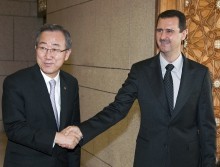
UN Secretary-General Ban Ki-moon (left) meets Syrian President Bashar al-Assad. Illustrative. Photo Courtesy of UN Photo/Eskinder Debebe.
Syrian President Bashas al-Assad on Sunday presented his plan for a ceasefire and political reforms in his country in a speech the government-affiliated Syrian Arab News Agency (SANA) said was delivered at the Opera House in Damascus. Previously it had been unclear where Assad was located during the chaotic civil war in his country. As the first step in a ceasefire, SANA quoted Assad as calling for the “terrorist” operations and the international arming of the “gunmen” opposing him to cease before the Armed Forces would stop their operations.
The Syrian military has been accused of shelling and besieging towns and killing civilians indiscriminately, while the US has verified the Assad regime has fired Scud missiles at targets within their own country. The United Nations has estimated that 60,000 people have died in the Syrian civil war, with the US accusing Assad of being the most responsible for the bloodshed.
Assad was paraphrased by SANA as saying that even after stopping military operations, his army has “the right of response if the security of homeland or citizens is threatened or public or private properties were attacked.”
Assad’s plan also calls for a national political dialogue that will lead to a vote for a new constitution and new parliamentary elections. A dictator for well over a decade that inherited his father’s reign, Assad did not explicitly note what would become of himself politically.
The US has repeatedly argued that Assad has lost his right to govern and must step down as part of a new Syrian political system.
The plan for dialogue proposed by Assad left it unclear how much of the opposition would be allowed to participate, as he questioned in his speech whether or not they should talk with what SANA termed as “gangs that are ordered from abroad.”
Assad attempted to portray the conflict not as an internal civil war, but as a war attacking Syria from the outside while using traitorous Syrians and terrorists as international proxies.
“It is not a matter of loyalists against opposition, nor an army vis-à-vis gangs and criminals,” Assad was quoted as saying. “…We are in a state of war in the full sense of the word… We are repelling a fierce outside aggression in a new disguise, which is more lethal and dangerous than a traditional war, because they do not employ their tools to strike us, but they have us implement their projects, and target Syria using a bunch of Syrians and a lot of foreigners.”
The Syrian conflict started in March 2011 as the opposition peacefully took to the streets to protest against the Assad regime. The authorities responded with a vicious crackdown that killed a number of Syrians and sparked international outcry.
Later the opposition became increasingly militant, leading to the civil war raging today.
(By Joshua Spurlock, www.themideastupdate.com, January 6, 2013)
